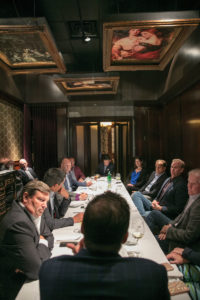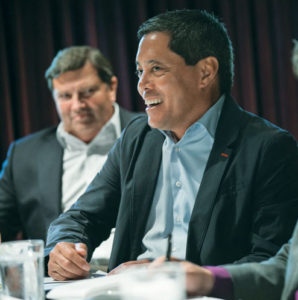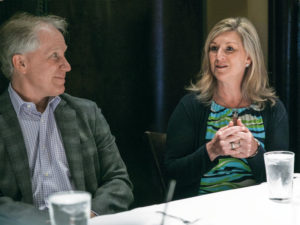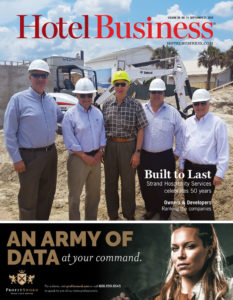
TOP ROW, LEFT TO RIGHT: Jim Chu, Hyatt Hotels Corp.; Jennifer Dakin, Wells Fargo; Robert Cole, HVMG; Rick Takach, Vesta Hospitality; Chris Diffley, Rockbridge; and Jon Witter, Hilton
BOTTOM ROW, LEFT TO RIGHT: Bill Stadler, Aimbridge Hospitality; Jim Merkel, Rockbridge; Carrie David, Interstate Hotels & Resorts; and John Belden, Davidson Hotels and Resorts
Photos: Colin McGuire
 COLUMBUS, OH—Hospitality companies have made social enterprise and philanthropy an integral part of their daily operations, not only because it is the right thing to do, but because customers and employees want it that way.
COLUMBUS, OH—Hospitality companies have made social enterprise and philanthropy an integral part of their daily operations, not only because it is the right thing to do, but because customers and employees want it that way.
Held here at Eleven restaurant, in conjunction with Rockbridge RTRX, which has raised millions of dollars for cancer research, the Hotel Business Executive Roundtable “Beyond the Boardroom: How Does Doing Social Good Benefit the Industry?” enabled 10 industry executives to discuss how responsible business is tied into their daily operations. The roundtable was hosted and sponsored by Rockbridge.
“[Social good] is an integral part of the way we do business in our organization, and it permeates throughout our company,” said Rick Takach, chairman/CEO, Vesta Hospitality. “When we do our business planning on an annualized basis, we have five spokes that we focus on: our team members, our guests, our profits, our revenues and responsible business. Everybody in our organization is focused on responsible business. It is sometimes a matter of the way you do business, and it is also the way we get involved in our communities and support our communities, which is very important to us. It is just something, from a culture standpoint, that we believe.”
Whereas in the past, social responsibility many times just meant offering financial support to a cause—essentially cutting a check—now companies are taking a more active role. “Our culture is evolving,” said Jim Merkel, CEO, Rockbridge. “This is a very bright spot in our community as we evolve as a society in the U.S. We are an extremely philanthropic country, but businesses are engaging in a way that they didn’t engage 20 years ago. It is really mission critical to businesses and their success to create these opportunities, which enables us to live in a better community.”
Jon Witter, chief customer officer, Hilton, is happy to see things have changed. “If you go back to 1980s geeky finance theory, I think a lot of people would say the purpose of for-profit companies is to maximize shareholder value, and if you are doing things that are engaged in philanthropy, in community service and so forth, it is a distraction for business,” he said. “What I very strongly believe, and I think you are hearing it in the voices around the table, is—and I am biased in saying this—a more enlightened view of that. We have talked about purpose. We have talked about culture—all of those things are critical to building an engaged workforce that is willing to bring their whole selves to work every day to deliver more than just a product, but to deliver the types of experiences we are talking about.”
Making the local communities better can only benefit a business. “I think companies have realized that if they are successful and the local communities aren’t, then you have problems with labor availability, you have problems with economic development, you have problems with the safety of those areas,” he said. “It creates a richness and it creates a system that works…More people are connecting those dots and saying it isn’t either/or. It is not returning value to shareholders or engaging community—actually, those two are opposite sides of the same coin.”
Bill Stadler, EVP/chief investment officer, Aimbridge Hospitality, which since the roundtable announced a merger with Interstate Hotels & Resorts, (see story on p. 5), said that this change had a lot to do with the dot-com companies of the ’90s and their entrepreneurial culture. “[They] really spearheaded a lot of those changes. The culture is certainly different today than it was 20 years ago,” he said.
Working together on a social cause can be a major factor in building a company culture and purpose. Chris Diffley, managing director, Rockbridge, said that the company’s work on RTRX, a leadership event in which attendees network and share a commitment to supporting cancer research, has done just that. “It doesn’t take money; it has created a great culture,” he said. “It is great fulfillment for our team members… It is very important for all of the leaders inside of Rockbridge to get all of our team members engaged. We create engagement in so many different ways—the whole year we are doing fundraising efforts and different team-building events that engage the whole team, which creates fulfillment for everybody. It is much more than just raising money.”
For her part, Carrie David, chief HR officer, Interstate Hotels & Resorts, said her company engaged its employees when it came up with new core values this year.
“We went out and did roundtables, talked to our line associates, talked to our GMs,” she said. “If you created a word cloud of what kept coming forth most, it was ‘community.’ One of the values that we came forth with was ‘Think we, not me.’ It is all about the team spirit within Interstate, but also in our communities.”
She continued, “Similarly, we give annual awards for what we call ‘Interstate Gives Back.’ It has to be relevant for them and their communities, especially in a company like Interstate. We have 60 different brands, so what our owners care about and the purpose of the local communities are just totally different. It is everything from soup kitchens to giving battered women skillsets and helping them with their resumes, to cleaning up the local parks; it is a whole gamut of things that just make us proud to be Interstate. That fabric is so much a part of our culture. It wasn’t deliberate before, but now we deliberately have our hiring practices and how we look at who gets those coveted GM positions—people who really embody that and really have that as one of their key values internally.”
Robert Cole, founder/president/CEO, HVMG, said that community involvement is a key component at each of his company’s 45 properties—and each type of involvement is dictated by the local GMs. “What we try very hard to do is get our GMs—we call them our CEOs—to buy in to community involvement and to make sure that it is their idea and is going to work for them and their communities,” he said. “The brand of the hotel is dictated by what those general managers do and, every year, part of their strategic plan is to come up with what they are going to do from a community involvement standpoint, to be the employer of choice, to be recognized in the community as somebody who is very engaged and very community involved.
“Getting their buy-in is easy once it is their idea,” he added. “If we say, ‘OK, here is what we are going to do as an organization, now all 45 hotels, go commit to that,’ they will do that because they are being told to do it. But, I think it is very important to—as much as possible—let these ideas bubble up from the field. A big part of our award winners every year, our Hotel of the Year and our GM of the Year, is what they did from a community standpoint and social perspective. That is just as important as revenue, market share and flow through.”
Jim Chu, global head of development and owner relations, Hyatt Hotels Corp., said that community involvement gives employees empowerment. “Great communities have great engagement from the companies that do business there, that serve the community through the form of employment and engagement, whether it be through the hospitality side or the restaurant side, or on the retail side,” he said. “That is what bridges great communities, great cities, great states and great countries. I think there is a responsibility that we all probably organizationally feel, and all drive some aspect of that—that is something that probably resonates. I am so proud that we have been able to continue to talk about that culture at the property level because that is where we all do business—that is where the difference is made, in the communities where people live.
“That is why, overall, although it is good to feel like you could be a great leader, it is really the employees who are driving it,” he said. “They want to be engaged where they live. What resonates with me is everybody supports that. These organizations all are supporting that, and that gives a sense of pride to all of our colleagues.”
Employee involvement can also be increased by the use of gamification. “Everything is gamified, so create competitions—we have volunteer challenges between departments, and everybody gets to compete,” said John Belden, chairman/CEO, Davidson Hotels and Resorts, whose main charity is Give Kids the World. “Everybody wants to do it for all the right reasons, but having a little extra challenge can add to it. All of our teams are pretty darn competitive. I know that Jim [Merkel] is not only proud of going from $30,000 [of giving in RTRX’s first year]to $1.1 million [recently], but there is an insane emotional satisfaction in that, too. But rest assured, Jim wants to beat $1.1 million this year and on—there is just an innate competitiveness in all of us.”
For David, potential employees, especially among the millennial generation, are attracted to companies that are socially responsible and have a strong culture of giving back. “Employees want to work for companies that give them a purpose and that they believe have a mission,” she said. “You see a lot of public companies focus on the ESG disclosures [environmental, social and governance—the three central factors in measuring the sustainability and ethical impact of an investment in a company or business] now, but I think it is because there is just a groundswell of what people care about. I think some of it is the millennial generation, and some of it is the people reaching for more meaning period. It is going to become an increasingly integral part of business; it is important because employees are going to feel more engaged and they are going to feel like they are really driving something and getting meaning out of the work experience because of the way our companies give back to communities.”
Potential guests are also interested in a company’s commitment to social responsibility. “Some of our recent research shows 35% or more of customers research a company’s commitment to social responsibility and their purpose as a gauge to see whether they want to spend money with that company,” said Witter. “My guess is that number is only going to increase over time.”
When it comes to giving back to charitable causes, Witter said that companies can do more than just provide money or time. “There is always going to be a need for pure giving, but I also think there are chances to get really creative,” he said. “I got a call 18 months ago from the head of a national charity looking for support from Hilton. I said to the CEO, ‘We could write you a check for a year or two, but something will happen down the road because what you do isn’t core to our philanthropic priorities—and for all the best intentions, at some point, that will go away. Why don’t we figure out something different? Why don’t we figure out a permanent way to help you guys with what you really need?’”
Hilton put together a program for the organization in which special reservation numbers, rate codes and referral arrangements were created so when those who are recipients of the charity need hotel space, they can refer directly to Hilton properties. “It is a win-win because it is a very competitive cost of distribution channel, and they do all of the marketing for us. They bring us a huge amount of their group business and we take all of those commissions, which our hotels and owners would have paid anyway, and we actually donate those back to the charity,” he said.
He continued, “We are effectively allowing them to monetize the affinity that people have for that brand. If you met the people who are receiving support from that organization, there is a massive market affinity. They want to support that organization.”
For corporate philanthropy to be a successful endeavor for both the cause and the company-culture aspect, it is important to have a good, stable platform, as well as leadership to really drive the success, according to Jennifer Dakin, SVP, team leader, Wells Fargo. “I also like the ‘we versus me’ [attitude]because I definitely believe that and say that in a lot of my communication—because it is a team effort, and you also have to engage your team members so they feel involved, rewarded and like they are making an impact,” she said. “That is when it is going to resonate more with them and be more powerful. Together, we become this massive powerhouse and can conquer a lot of different things and set new challenges for ourselves. But, it is also fun at the end of the day, too. It is not a task; it is fun to be around people who you build relationships with and who you work with on a day-to-day basis, but then you are able to do something that is outside of your business activities—and it is actually impacting the communities and impacting your friends and families.” HB
Check out our video interviews at video.hotelbusiness.com





